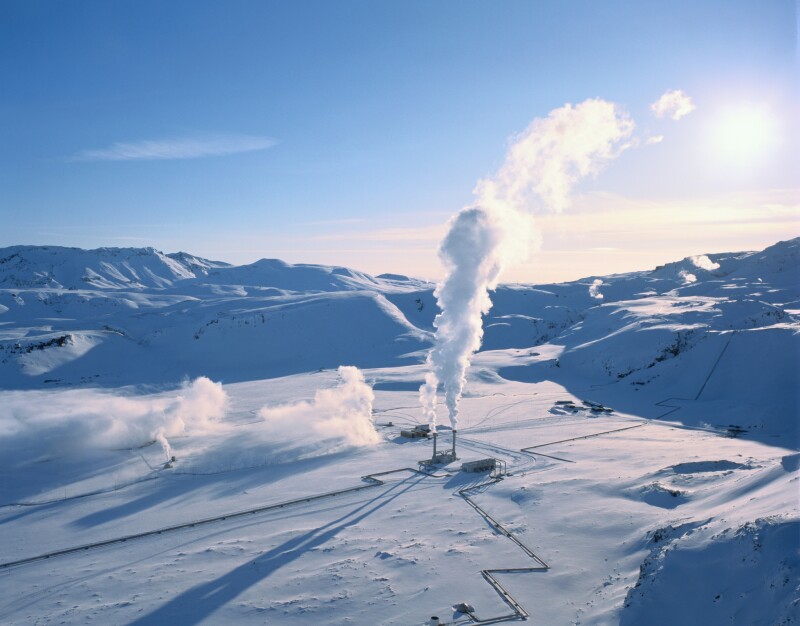I have been helping Rebecca Schulz, John Clegg, and our Production and Facilities representative, George Brindle, get a SPE Geothermal Discussion Group off the ground as a new community of SPE Connect.
So, why not take the risk of getting myself into hot water by writing an article on a topic that I know little about? (This idiom is presumed to be an allusion to using water hot enough to scald … or, maybe, to get a red tinge as when embarrassed. It likely dates to the 16 century and was in common usage by 1765.)
An Early Introduction to Geothermal
For me, this long and winding road to acquiring a basic grounding in geothermal exploration and production (E&P) stretches back to the mid-1980s. Petro-Canada International Assistance Corporation (PCIAC) and the World Bank were drilling a geothermal well near Hell’s Gate in the Lake Naivasha area of Kenya’s Rift Valley. My supervisor advised, “Check it out over the weekend. You are going to be there anyway. The testing kit and sampling requirements should be similar to those for any high-rate, HP/HT (high-pressure/high-temperature) land wells.”
Shortly after that I got the opportunity of a site visit to a push-down rig drilling a slimhole geothermal gradient assessment well in northeast Thailand. If the well encountered fractured pay, the operator proposed to test the flow capacity and collect fluid samples using much more cost-effective, lower-technology approaches than I would have proposed. At that point, as a newly minted consultant, I realized that there was lots more to be learnt about the E&P business.
With increasing frequency over the next few decades, questions would pop up about
- Using the produced water from the freewater knockout vessels to heat or cool offices and accommodation, preheat water elsewhere in the process, or to power underflow evaporators.
- The economics of deepening the water supply wells to obtain hotter water for the line heaters to reduce fuel gas usage.
- Selling heat and water to a nearby horticultural operations, instead of attempting a difficult water shutoff in an overpressured well, and then recycling the cooled water via a subeconomic down-dip well.
- Finding high-temperature, slimhole logging tools and subject matter experts.
- Identifying well engineers with hard-rock drilling, thermal modeling, and/or high-temperature well-design experience.
It slowly dawned on me that I needed to learn a lot more about the emerging enhanced geothermal systems (EGS), as well as other concepts for extracting heat from hot dry rocks (HDR); deep, high permeability aquifers; and/or the stock of suspended oil and gas wells.
Resources for Learning
Volume VI of the Petroleum Engineering Handbook, published in 2007, included a chapter on geothermal engineering by J.L. Renner et al. This has been reproduced and partially updated in PetroWiki, and provides a good summary of conventional geothermal energy projects and a brief introduction to EGS. (Hopefully, volunteers from the SPE Geothermal Discussion Group will update this text in the not-too-distant future.)
In 2013, John Ziagos et al. published: “A Technology Roadmap for Strategic Development of Enhanced Geothermal Systems” in the Proceedings of the 38th Workshop on Geothermal Reservoir Engineering at Stanford University (SGP-TR-198).
At that time, I was working on a deep tight-gas sand exploration program in Australia, with a well engineer who had worked for Geodynamics on the Habanero Project near Innamincka in the Cooper Basin, South Australia (SEG 2010-1100, SPE 167067, and Geothermal Resources Council Transactions Vol. 41 [2017]). Drilling and completing these HP/HT EGS wells proved to be especially challenging. A well failure had occurred in 2009, with the most probable cause being caustic stress corrosion cracking resulting from unset cement and/or cyclic pressure and temperature loading of the casing string. Therefore, a completely new approach to cementing was used for the Habanero 4 well (as discussed in SPE 167067).
Clearly, despite the similarity between the work flows, technology transfer between geothermal and oil and gas well construction subject matter experts (SMEs) needs to work both ways. The transition is going to be a lot more challenging than many petroleum engineers and new ventures managers assume.
Therefore, it is no surprise that an upcoming joint SPE and Geothermal Rising workshop will discuss high-temperature cementing. It is scheduled for October 2021 in San Diego, California.
At about the same time in 2014, on the opposite side of the world and at the other end of the geothermal performance spectrum, Bjorn Mar Sveinbjornsson of the Iceland GeoSurvey (ÍSOR) published a fascinating paper, “Success of High Temperature Geothermal Wells in Iceland.” (ÍSOR-2014/063 prepared for the Icelandic National Energy Authority, Orkustofnun).
This report reviewed more than 200 geothermal production wells and 21 injection wells in seven Icelandic geothermal projects.
- 74% of the wells were successful, and none of the prospects had a success rate below 50%.
- Only some 6% of wells failed due to drilling problems, although a further 3% did not reach the reservoir.
- 10% of the wells did not have a high enough static pressure.
- 4% found inadequate temperatures.
- Only 3% had inadequate fracture permeability.
As most of us might anticipate, the exploration phase has the most variable well success rates, but those increase with time and experience in the area so that the average success rate improves to 60% over the first five wells. The success rate reaches the plateau after some 15 wells.
Development wells with large production casing sizes (from 11.75 to 13.75 in. [298–350 mm]) had the greatest thermal delivery capacity, averaging nearly 9 MWe/well. An increased contact angle in the pay also increased the capacity compared to vertical wells.
The paper also reports an increase in capacity with enthalpy, so that
- Wells drilled into the steam chamber above two-phase reservoirs had the highest capacity, even at lower initial temperatures (230‒240°C).
- Deeper wells drilled into two-phase reservoirs with temperatures over 300°C had an average capacity of about 6 MWe and a lower success rate.
Last year, George Brindle of Skoki Energy Advisors gave me a transcript of his talk to the Canadian Society of Petroleum Geologists, entitled “Geothermal Projects and The Second Law of Thermodynamics.” This two-part discussion of thermal energy losses and mitigation measures was a great refresher on everything that I had forgotten about thermodynamics, heat transfer, systems engineering, heat exchangers, and the risks of scaling and fouling. He has offered a Reader’s Digest version to the SPE Distinguished Lecturer Committee, hopefully, for the 2022–2023 season, as well as an expanded version as part of an SPE Training Course on Geothermal Facilities Engineering.
Talking of SPE Training Courses, another Canadian, Mazda Irani, Ashaw Energy Ltd., is presenting his course on Geothermal Reservoir and Hydraulics Design in late May.
In January 2021, JPT Technology Editor Judy Feder wrote an excellent article, “Geothermal Well Construction: A Step Change in Oil and Gas Technologies.”
But maybe, that should be read as a step change to oil and gas technology transfer, or knowledge dissemination on evolving geothermal technologies for SPE members.
For sure, there are lots of new terms and three-letter acronyms to confuse the uninitiated neophyte.
- CLG: Closed-loop geothermal, in which fluid circulation does not involve the aquifer
- EGS: Enhanced geothermal systems which include fracture stimulation of the pay zone
- FORGE: Frontier Observatory in Research in Geothermal Energy, the US Department of Energy (DOE) Geothermal Technologies Office (GTO)
- HDR: Hot dry rocks, which may not actually be dry (except with respect to the unstimulated flow capability)
What is in this for us production and facilities types? A lot, especially for those who have worked on
- Thermal heavy oil projects and heat management.
- Inorganic scaling risk assessments and mitigation.
- Water treatment.
- Electrification or power distribution.
- Complex multifunctional project engineering.
As with many new ventures, the opportunity assessment phase is particularly challenging. Getting through PMP Stage Gates 1 and 2 requires projects, facilities, and construction support to develop reasonable and appropriately risked costs estimates and schedule ranges for commercial analysis.
Webinars and Virtual Events on Geothermal Energy
If, like me, you prefer listening to webinars for background more than reading, several of the SPE geographic sections have useful material on their websites.
SPE webinars on geothermal-related topics that I have watched over the past 12 months of COVID-19 lockdown include:
- Dr. Gioia Falcone’s lecture to the Aberdeen Section, “Oil and Gas Expertise for Unconventional Geothermal Opportunities.”
- Charlene Wardlow’s talk on geothermal energy to the SPE California Sustainability Study Group
- Matt Toews’ presentation to the Calgary Section Young Professionals, “Eavor Technologies—A Game Changer in the Renewable Power Market.”
- Dave Brown’s talk to the Calgary Section’s Drilling and Completions Special Interest Group on Deep Earth Energy Production (DEEP): An Overview of Well Design and Testing Considerations on Canada’s First [Commercial Scale] Geothermal Development.
The learning curve can be flattened by leveraging the learnings of those who are active in this space and by visiting the websites of their professional organizations and those universities that have been serving the geothermal industry for many years. This includes, but is not limited to:
- Geothermal Rising (GR/GRC)
- International Geothermal Association www.geothermal-energy.org
- US DOE Geothermal Technologies Office
- California Department of Conservation, Geothermal Resources Group
- IEA Technology Collaboration Program, which includes geothermal
Of course, there are many more national, international and industry groups, including the Australia and Canadian associations (AGA and CanGEA); the Geothermal Union in Italy (UGI); the SMU Geothermal Lab; and the Geothermal Entrepreneurship Organization (GEO) at The University of Texas at Austin.
The delayed 2020 World Geothermal Congress has finally kicked off as a hybrid event with
- The Drilling, Completions, and Engineering Virtual Session on 15 June.
- An on-site closing face-to-face semester proposed for October 2021 in Reykjavik, Iceland.
The SPE Geothermal Discussion Group is also planning to participate in Pivot2021 in July. This free virtual event is sponsored by the DOE. The SPE, AAPG, SEG, IGA, GEO, and other organizations are supporting the event with some 35 panel sessions being planned.
Last year’s event, Pivot2020, was subtitled “Kicking-Off the Geothermal Decade” and was hosted by the Geothermal Entrepreneurship Organization based at The University of Texas at Austin and the International Geothermal Association.
That should be more than enough to get you started. Enjoy adventuring into something new and remember that those you meet along the way may be as valuable as what you learn.
FOR FURTHER READING
Geothermal: Digging Beneath the Surface by Judy Feder, JPT Technology Editor
Oil’s Wisdom Heats Up Drive for Geothermal Energy by Adam Wilson, HSE Now, SPE Special Publications Editor
Heavy-Oil Technology May Be a Perfect Fit for Geothermal Power by Trent Jacobs, JPT Digital Editor
US Geothermal Power Technology Shifts From Steam to Binary Cycle, Oil and Gas Facilities


